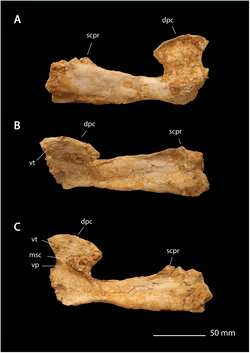Simurghia
| Simurghia | |
|---|---|
 | |
| Holotype humerus | |
| Scientific classification | |
| Kingdom: | Animalia |
| Phylum: | Chordata |
| Order: | †Pterosauria |
| Suborder: | †Pterodactyloidea |
| Clade: | †Pteranodontia |
| Family: | †Nyctosauridae |
| Genus: | †Simurghia Longrich, Martill, & Andres, 2018 |
| Type species | |
| †Simurghia robusta Longrich, Martill, & Andres, 2018 | |
Simurghia is a nyctosaurid pterosaur from the Ouled Abdoun Basin of Morocco and dates to the Maastrichtian of the Late Cretaceous. It was published in 2018 by Nicholas R. Longrich, David M. Martill, and Brian Andres along with another nyctosaur from the same basin, Barbaridactylus.[1] It includes one species, Simurghia robusta.
Discovery and naming
All known specimens of Simurghia were uncovered in a 3-year dig that unearthed about 200 pterosaur specimens. The type specimen, FSAC-OB 7, consists of a nearly complete humerus, lacking only the humeral head and the ulnar crest.[1]
Simurghia is named after a flying beast from Persian mythology known as the Simurgh. The species name, S. robusta, is a Latin word that means "robust."[1]
Classification
A phylogenetic analysis by Longrich et al. uncovered Simurghia as a member of Nyctosauridae.[1]
|
| ||||||||||||||||||||||||||||||||||||||||||||||||||||||||||||||||||||||
Paleobiology
Simurghia is similar in form to Alcione, but is unlikely to represent an adult of this species. All specimens of Alcione are either subadults or adults, based on their bone's dense avascular surface texture, well ossified condyles, and fused synsacrum and scapulocoracoid. Additionally, lack of intermediately sized humeri would suggest that these pterosaurs are distinct from each other. Using isometric scaling, Simurghia would weigh 560% more than Alcione, making sexual dimorphism or intraspecific variation unlikely.[1]
Paleoecology
Simurghia was discovered in upper Maastrichtian phosphates located in the Ouled Abdoun Basin of Northern Morocco. This geological formation does not belong to a formation. It is divided into couches, with Simurghia being discovered in Couche III. This layer dates back to the latest Maastrichtian, about 1 million years before the extinction event at the end of the Cretaceous. Couche III represents the most diverse marine ecosystem known from the time.[1]
A large variety of marine life is known from the region, including sharks and bony fish, in addition to turtles, plesiosaurs, and mosasaurs. A few rare, fragmentary dinosaur fossils are known, including an abelisaur and a sauropod. Other pterosaurs in the formation were originally only represented by the azhdarcid Phosphatodraco mauritanicus. However, in addition to Simurghia, more recent studies have revealed at least five more pterosaur species from this location, including Barbaridactylus, Alcione elainus, and Tethydraco.[1]
References
- 1 2 3 4 5 6 7 Nicholas R. Longrich; David M. Martill; Brian Andres (2018). "Late Maastrichtian pterosaurs from North Africa and mass extinction of Pterosauria at the Cretaceous-Paleogene boundary". PLOS Biology. 16 (3): e2001663. doi:10.1371/journal.pbio.2001663. PMC 5849296 Freely accessible. PMID 29534059